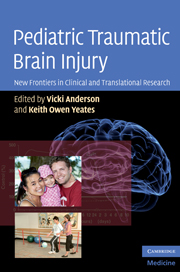Book contents
- Frontmatter
- Contents
- List of contributors
- Acknowledgments
- Introduction: Pediatric traumatic brain injury: New frontiers in clinical and translational research
- 1 Biomechanics of pediatric TBI
- 2 Neurobiology of TBI sustained during development
- 3 Using serum biomarkers to diagnose, assess, treat, and predict outcome after pediatric TBI
- 4 Clinical trials for pediatric TBI
- 5 Advanced neuroimaging techniques in children with traumatic brain injury
- 6 Neurobehavioral outcomes of pediatric mild traumatic brain injury
- 7 Very long-term neuropsychological and behavioral consequences of mild and complicated mild TBI: increased impact of pediatric versus adult TBI
- 8 Neurobehavioral outcomes of pediatric traumatic brain injury
- 9 Neuropsychological rehabilitation in children with traumatic brain injuries
- 10 Psychosocial interventions
- 11 Pediatric TBI: challenges for treatment and rehabilitation
- 12 Integrating multidisciplinary research for translation from the laboratory to the clinic
- Index
- Plate section
- References
12 - Integrating multidisciplinary research for translation from the laboratory to the clinic
Published online by Cambridge University Press: 14 May 2010
- Frontmatter
- Contents
- List of contributors
- Acknowledgments
- Introduction: Pediatric traumatic brain injury: New frontiers in clinical and translational research
- 1 Biomechanics of pediatric TBI
- 2 Neurobiology of TBI sustained during development
- 3 Using serum biomarkers to diagnose, assess, treat, and predict outcome after pediatric TBI
- 4 Clinical trials for pediatric TBI
- 5 Advanced neuroimaging techniques in children with traumatic brain injury
- 6 Neurobehavioral outcomes of pediatric mild traumatic brain injury
- 7 Very long-term neuropsychological and behavioral consequences of mild and complicated mild TBI: increased impact of pediatric versus adult TBI
- 8 Neurobehavioral outcomes of pediatric traumatic brain injury
- 9 Neuropsychological rehabilitation in children with traumatic brain injuries
- 10 Psychosocial interventions
- 11 Pediatric TBI: challenges for treatment and rehabilitation
- 12 Integrating multidisciplinary research for translation from the laboratory to the clinic
- Index
- Plate section
- References
Summary
An important development in behavioral neuroscience in the last 20 years has been the demonstration that it is possible to stimulate functional recovery after brain injury in laboratory animals. A significant challenge for the next 20 years is the translation of this work to improve the outcome from brain injury and disease in humans. Rodent models of early brain injury provide a tool for developing such rehabilitation programs. The models include analyses at different levels including detailed behavioral paradigms, electrophysiology, neuronal morphology, protein chemistry, and epigenetics. Our goal here is to synthesize this multidisciplinary work to provide a platform for moving to the clinic.
The road to translation begins with a search for an understanding of brain development and the factors that modify “normal” development. This allows us to outline a series of principles of cerebral plasticity that provide a framework from which to launch a search for rehabilitation treatments for animals with injuries of varying etiologies. By necessity this requires an investigation of behavior, neuronal morphology, neurophysiology, protein chemistry, and genetics/epigenetics. By using this strategy, we have been able to identify a variety of factors that influence functional recovery and brain plasticity, including the demonstration that both pre-natal factors and peripheral stimulation can profoundly influence functional outcome after perinatal brain injury.
Background
Assumptions and hypotheses
The underlying assumption of our experiments is that there are critical periods during development in which the brain is more able to reorganize, and others where it is less able to reorganize, to allow restoration of function after cerebral injury.
- Type
- Chapter
- Information
- Pediatric Traumatic Brain InjuryNew Frontiers in Clinical and Translational Research, pp. 207 - 224Publisher: Cambridge University PressPrint publication year: 2010



